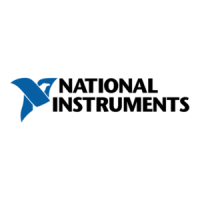Glossary
M Series User Manual G-4 ni.com
bus, buses The group of electrical conductors that interconnect individual circuitry in
a computer. Typically, a bus is the expansion vehicle to which I/O or other
devices are connected. Examples of PC buses are the PCI, AT(ISA), and
EISA bus.
C
CCelsius.
calibration The process of determining the accuracy of an instrument. In a formal
sense, calibration establishes the relationship of an instrument’s
measurement to the value provided by a standard. When that relationship is
known, the instrument may then be adjusted (calibrated) for best accuracy.
calibrator A precise, traceable signal source used to calibrate instruments.
cascading Process of extending the counting range of a counter chip by connecting to
the next higher counter.
CE European emissions control standard.
channel Pin or wire lead to which you apply or from which you read the analog or
digital signal. Analog signals can be single-ended or differential. For digital
signals, you group channels to form ports. Ports usually consist of either
four or eight digital channels.
clock Hardware component that controls timing for reading from or writing to
groups.
CMOS Complementary metal-oxide semiconductor.
CMRR Common-mode rejection ratio—A measure of the ability of a differential
amplifier to reject interference from a common-mode signal, usually
expressed in decibels (dB).
common-mode
rejection
The ability of an electronic system to cancel any electronic noise pick-up
that is common to both the positive and negative polarities of the input leads
to the instrument front end. Common mode rejection is only a relevant
specification for systems having a balanced or differential input.

